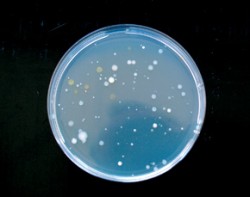I moderní alaboratorně náročné metody dávají velmi omezenou možnost stanovení druhové struktury bakteriální složky vodních společenstev. Jejich popis tedy nemůže být identický se společenstvy rostlinnými nebo živočišnými. Rozhodující roli ve struktuře i funkci bakteriálních společenstev hrají podmínky prostředí, na které mohou společenstva reagovat vedle selekce také adaptací na genové úrovni. Významná je interakce s ostatními složkami systému – primárními producenty a konzumenty, kteří regenerují zdroje organického uhlíku.
Amann,R.I., Zarda,B., Stahl,D.A., and Schleifer,K.-H. (1992): Identification of individual prokaryotic cells by using enzyme-labelled, rRNA-targeted oligonucleotide probes. Applied and Environmental Microbiology 58, s. 3007-3011.
Begon, M., Harper, J.L., Townsend,C.R. (1997): Ekologie - jedinci, populace, společenstva. Vydavatelství Univ. Palackého, Olomouc, 949 s.
Fuksa, J.K. (2007): Toky jako recipienty odpadních vod – dnes a zítra. VTEI 49 (3), příloha Vodního hospodářství 57(10), s. 1- 4.
Hobbie,J.E., Daley,R.J., and Jasper,S. (1977): Use of nuclepore filters for counting bacteria by fluorescence microscopy. Applied and Environmental Microbiology 33 (5), s. 1225-1228.
Holt,J.G.; Krieg,N.R.; Sneath,P.H.A.; Williams,S.T. (1994): Bergeys Manual of Determinative Bacteriology. Ninth Edition. Williams a. Wilkins, 787 s.
Maier,R.M., Pepper,I.L., Gerba,C.P. (2000): Envorinmental Microbiology. Academic Press, 585 s.
Porter,K.G. and Feig,Y.S. (1980): Use of DAPI for identifying and counting aquatic microflora. Limnol.Oceanogr. 25, s. 943-948.
Razumov,A.S. (1932): Prjamoj metod učota bakterij ve vodě. Sravněnije jego s metodom Kocha. Mikrobiologija 1 (2), s. 131-154.
Sigee,D.C. (2005): Freshwater Microbiology. Biodiversity and dynamic interactions of microorganisms in the aquatic environment., J. Wiley a. sons, 523 s.
Even modern methodology with sophisticated laboratory equipment offers only a limited opportunity to identify the species structure of the bacterial component of water communities. Thus it cannot be described in the same way as plant or animal communities. Environmental conditions play a decisive role in the structure and function of bacterial communities. Interaction with other components of the system – primary producers and consumers, which regenerate sources of organic carbon, is important as well.
 Miska po kultivaci vzorku vody na nespecifickém agarovém médiu. Kolonie lze již podle barvy a tvaru atd. zařadit a dále identifikovat. Jsou to však obecně kopiotrofní typy (vázané na vysokou koncentraci organického uhlíku v prostředí), ve vodních ekosystémech nepůvodní. Foto J. K. Fuksa / © J. K. Fuksa
Miska po kultivaci vzorku vody na nespecifickém agarovém médiu. Kolonie lze již podle barvy a tvaru atd. zařadit a dále identifikovat. Jsou to však obecně kopiotrofní typy (vázané na vysokou koncentraci organického uhlíku v prostředí), ve vodních ekosystémech nepůvodní. Foto J. K. Fuksa / © J. K. Fuksa 



